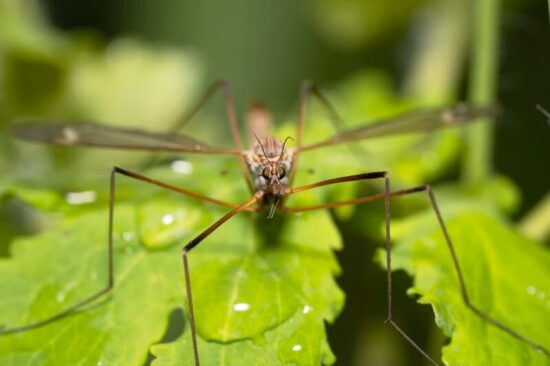Many people have a completely inaccurate idea of what crane flies eat. Due to some confusing nicknames and the side of these insects when they’re adults, it’s not hard to see why.
This guide will explore the diet of a crane fly, if they eat mosquitoes or not, and what you can expect from their eating habits at each stage of their life.
Table of Contents
What Do Crane Flies Eat?
Crane flies are a widely misunderstood insect. They look strikingly similar to mosquitoes. As a result, they’re often lumped in with the bloodsuckers.
Mosquitoes are responsible for health problems all over the world. While seemingly innocent during most encounters, mosquitoes can transmit potentially life-threatening diseases.
Fortunately, crane flies aren’t so dangerous. But their similar appearance to the dreaded mosquito does make the relatively harmless bug a target. Contrary to popular belief, crane flies do not eat human or animal blood.
In fact, they don’t eat much of anything at all! Adult crane flies do not possess the mouth parts needed to consume blood like mosquitos. They can’t sting you or inject any blood-sucking appendages into your skin. The bugs are also incapable of eating other insects.
If crane flies need to feed for whatever reason, it’s usually pollen or nectar. Easily accessible nectar from flowers and plants is usually the go-to. However, even those instances are rare.
You see, crane flies typically don’t eat as adults. The insects do all of their eating during the larval stage. As mature adults, they only have their sights set on mating.
The crane fly life cycle is fascinating. Mature adults will mate and lay eggs in moist soil, water, or even floating bats of algae. The eggs hatch, and the larvae get to work establishing themselves and eating anything they can. More on that soon.
Eventually, they grow into pretty large adults. The adults have long, skinny legs and girthy bodies. There are many different crane fly species in the world, but they all have a similar profile that looks like a mosquito.
The main priority of an adult is to mate and repeat the life cycle. They’re so focused on meeting that goal that most crane flies actually don’t eat. Luckily, crane flies typically don’t need food anyway.
The reason why adult crane flies don’t eat is because their lifespans are surprisingly short. The crane fly will live 10 to 15 days on the upper end of the scale. However, many die after only a few days of adulthood.
The short life span makes finding a mate even more critical. It’s the only way to continue the population and secure future generations.
Many entomologists believe that the unique life cycle of the bug caused the bug’s form to evolve into what it is today. The lack of traditional mouthparts is an example of evolution at play.
Most crane flies don’t have any mouth opening to feed. Those that have something to work with are usually limited to sipping nectar. It’s a unique way to live, but it continues to work for these short-lived insects.
Expert Tip: The nice thing is that this strange life of the crane fly works in favor of humans. No crane fly in the world is capable of biting a human, so they’re one bug you never have to worry about. They might look menacing and mosquito-like, but crane flies are the epitome of harmless.
What Do They Eat When They’re Larvae?
Adult crane flies don’t eat anything, but the insect has to get energy from somewhere. That’s why the larval stage is so vital to its life cycle. Unfortunately, that’s where crane flies become a bit more frustrating.
As mentioned earlier, adult crane flies will typically lay their eggs in moist soil. Entomologists believe that they gravitate to small bodies of water and prefer to lay eggs in the soil nearby.
Soil is the perfect place for eggs to incubate before larvae emerge. It’s warm and sustains various life forms. Plus, soil offers abundant food sources for the young!
In the larval form, crane flies sometimes go by the name “leatherjackets,” and they’re the bane of farmers around the globe! Crane flies eat quite a bit when they’re in the larva stage, and they’ll continue to eat until they’re ready to move into adulthood.
The larvae are grayish-brown and have that signature worm-like shape. They’re pretty thick, and the body tapers to the head. If you ever happen to pick one out of the soil, you’ll notice that the larvae often have spots and welts.
The pests also develop tough protective coverings. That’s where they get their “leatherjacket” moniker!
Another thing you’ll notice is the filament-like projections coming from their body. This appendage helps the larva anchor itself to the substrate.
Let’s talk about what crane flies eat when they’re larvae.
The reason why farmers hate crane fly larvae is that they eat plant roots. Roots are easily accessible to larvae in the soil. It’s plentiful, and the pests will eat as much of it as possible.
Grass roots are the most common target. However, the crane fly larva will also eat delicate seedlings, establish plant roots, and other types of vegetation. They’ll also feed on decaying wood, fungi, algae, and more.
When they attack plant roots, the effects can be devastating! Adult crane flies can deposit up to 300 eggs. Larvae are rarely alone, and they typically occur in large droves. Multiply the insatiable appetite of a single larva by 300 or so, and you’re looking at massive damage.
Crane fly larvae can ruin farm plots. When they start feeding, the vegetation above typically becomes yellow. It slowly dies off. When farmers eventually unearth the plant, the roots are practically gone!
This phenomenon is most jarring with grass. Crane fly larvae can eat so much of the root system that the grass pulls up like a piece of carpet. Nothing is anchoring it down, so most grass quickly dies.
The issue is serious for farmers. Massive colonies can ruin entire plots and prevent crops from reaching maturity. They’re particularly troublesome around the early spring.
Crane fly larvae that attack farms during spring tend to ruin the roots of young plants, preventing them from growing at all.
Fortunately, there are many ways to deal with crane flies that are eating plants and crops. The most common method is to use pesticides on the soil. The treatment should prevent adult flies from laying their eggs in the soil.
If they do, the solution typically prevents the eggs from hatching. However, there is the issue of using pesticides in crop fields. In those instances, a farmer might explore more natural alternatives.
Introducing nematodes is a common technique for dealing with crane fly larvae. The microscopic worms can deal with some crane fly species, eliminating the pests before they become a massive headache.
Do Crane Flies Eat Mosquitoes?
Have you ever heard someone refer to a crane fly as a “mosquito hawk” or “skeeter-eater?” Those are pretty common nicknames for these bugs (we’ll tell you why later).
But contrary to popular belief, crane flies do not eat mosquitoes. Many falsely believe that these bugs are allies in the fight against the blood-sucking pest. Unfortunately, they’re about as useless as a common housefly when it comes to this.
Remember that the lack of traditional mouthparts means adult crane flies don’t eat much of anything. Most species have no mouth opening at all, and the ones that do can only sip from nectar. The adult bugs have no means to take out mosquito populations.
They’re incapable of biting mosquitoes, eating them, or doing much of anything to them. They look menacing, and many people mistake the large size for a show of dominance over the lowly mosquito. It’s not hard to see why.
Crane flies are significantly larger than mosquitoes. Their bodies are thicker, and a fully grown adult’s wingspan can reach two inches wide. However, none of that helps an insect with no mouth.
Despite the intimidating appearance, crane flies don’t eat mosquitoes and will not impact the surrounding number in any way. Mosquitoes do much more harm than crane flies, and these bugs can’t do anything to stop them.
Expert Tip: Even if they could, these bugs would likely ignore the bloodsuckers. With their limited life span, the crane fly’s priorities are laser-focused on finding a mate and establishing the next generation.
Why Are Crane Flies Called Mosquito Hawks?
Here’s an interesting tidbit of information about crane flies. The adults have no power to eat mosquitoes, but the larvae sometimes do. Once again, the larvae are the real domineering pest!
Some species of crane flies are carnivorous during the larval stage. Instead of eating roots, fungi, and decaying wood, they set their sights on small bugs. Usually, the larvae live in or near bodies of water.
This is where the nickname “mosquito hawk” is most relevant. If you know anything about the mosquito life cycle, you’ll know that they lay eggs in water. Mosquito larvae typically mature in standing water.
For carnivorous crane fly larvae, it can be a feast! These young bugs will consume all of the mosquito larvae in the vicinity. They’ll also chow down on aquatic bugs that might come their way.
The carnivorous variants have specialized mouthparts to shred prey. While those mouth parts go away when the bug reaches adulthood, the larvae are perfectly capable of eating other small bugs.
Expert Tip: In other words, flies have a reputation for controlling mosquito populations. But it’s only the larvae that do that.
Conclusion
As you can see, crane flies eat different things at each stage of their life. And despite their nickname, these insects don’t eat mosquitoes unless the perfect situation presents itself when they’re larvae.
If you’re still confused, feel free to send over any questions you have. We’ll do our best to answer them as soon as possible!


